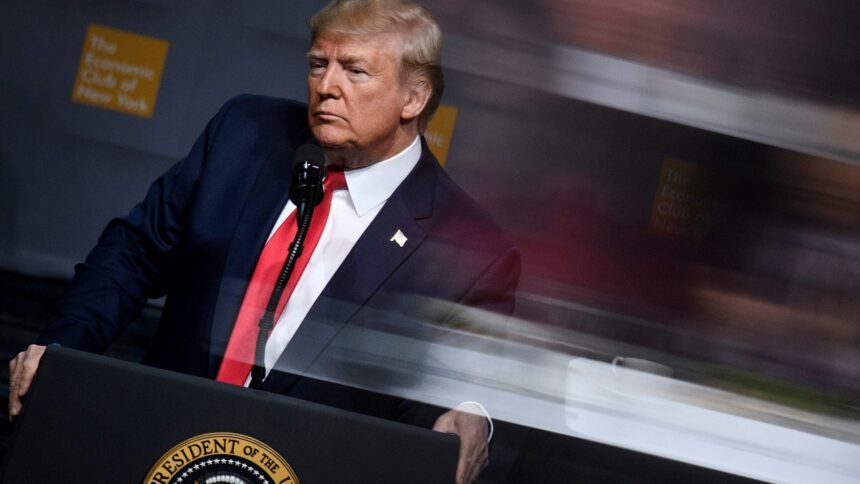- President Trump has referred to April 2 as “liberation day,” marking the day he plans to impose new tariffs on imported goods.
- Trump argues that tariffs will create a more balanced economic playing field for U.S. exports and encourage domestic manufacturing.
- Economists generally agree that tariffs lead to higher consumer prices, retaliatory tariffs from other countries, and negative impacts on consumer sentiment and stock prices.
For some weeks now, President Donald Trump has been calling Wednesday “liberation day,” the day he has promised to announce and thereafter enact widespread tariffs on the nation’s global trading partners.
Trump’s motive, as he has made clear since his first term in office from 2017-21, is to use tariffs — which is a term for a tax a country places on imported goods — as a way to force other countries to lower their own tariffs on U.S. goods and services, so as to create a more balanced economic playing field for U.S. exports, and to create a strong incentive for companies to manufacture goods (like cars, for instance) inside the U.S. to avoid paying the tax.
Problem is, economists widely agree that tariffs, if applied broadly, result in higher prices for consumer goods regardless of where they are being made, push other countries to raise their own tariffs instead of lowering them and, generally, hurt consumer sentiment and drive down stock prices at home, hurting investment.
With that in mind, let’s take a closer look at what this new “liberation day” is all about.
The idea of ‘Liberation Day’ isn’t anything new
A lot of the “Liberation Day” celebrations around the world are linked to the end of World War II in Europe and elsewhere. The French celebrate the liberation of Paris from the Nazis on Aug. 25, 1944, and the Italians celebrate the beginning of the popular uprising and general strike that overthrew the Fascists and Mussolini on April 25, 1945.
When did Trump begin referring to a ‘liberation day?’
It grew over several weeks in March of this year, though the formulation had a much longer run-up than that. Trump referred to several days as “liberation day” during his last presidential campaign. In February 2024, he told a conservative audience that Election Day, Nov. 5, “will he our liberation day” and repeated it several times after that. Then, Inauguration Day, Jan. 20, 2025, became “liberation day,” with Trump repeating that at his inaugural address.
During a speech to a joint session of Congress on March 4, Trump said, “We are achieving the great liberation of America but there still is much work to be done” and spoke about his plans to implement what he called “reciprocal tariffs” on other nations, adding “Whatever they tax us, we tax them.” By St. Patrick’s Day on March 17, Trump was telling reporters, according to the Washington Post, that April 2 “is a liberation day for our country because we’re going to be getting back a lot of the wealth that we so foolishly gave up to other countries.”
What’s going to happen on this ‘liberation day?’
As of this writing, on March 31, no one knows. Trump has already announced a lot of tariffs — on imported steel and aluminum, which are already in effect; on imported autos and auto parts, which are set to go into effect at midnight April 3, and have Detroit automakers extraordinarily concerned about the additional pressures and costs to Canadian and Mexican supply lines they rely on; on Chinese goods generally and any country buying oil from Venezuela — but the new set of taxes or tariffs are a mystery for now.
Trump first talked about a broad series of import tariffs that would not only match the tariffs charged by other countries but also account for other economic obstacles to U.S. trade, such as quotas that might limit the level of imports allowed into a country, or value-added taxes like those in Europe and elsewhere that can add to the price of imported goods. Then, as recently as last week, he was talking about being more lenient, saying otherwise his plans might be too tough and it looked like it might be restricted to certain trading partners. On Sunday night, he was again talking about them being broader and the Wall Street Journal said he was pushing aides to be more aggressive in applying them.
Still, there seemed to be some room for compromise. After imposing the auto tariffs last week, Trump and Canadian Prime Minister Mark Carney had a call after which Trump suggested negotiations were possible, adding, “I think things will work out very well between Canada and the United States.”
Does Trump have a point on trade and tariffs?
The United States runs a deficit in terms of its trade in goods and services with the rest of the world. In January of this year, that deficit — meaning the value of imports compared with the value of U.S. exports — was about $131 billion, up from about $98 billion in December. The U.S. hasn’t run a trade surplus, however, since the mid-1970s.
Trump has consistently argued that is proof the U.S. is treated unfairly by its trading partners, and some labor leaders, including the UAW’s Shawn Fain, have agreed, in part, saying tariffs will result in more work for U.S.-based manufacturing. And there are some claims that the U.S. may be more vulnerable financially or militarily if it doesn’t protect its ability to make things.
But there is another argument that in a world with global supply chains, it makes more sense economically and diplomatically for the U.S. to spend less than it otherwise might on some consumer goods by using imports to lower prices on some items, freeing up more for wages, savings, investment and other goods. It is hard for economists to imagine U.S. wages falling to a level where they would meet those in some other parts of the world and provide an advantage for U.S. exports. Meanwhile, there are questions as to what damage could be done to businesses; major manufacturers are not able to willy-nilly change product lines, open factories and alter supply chains, circumstances that can take years to plan and execute, lasting longer than a president’s term.
If Trump is able to use tariffs as a way to pull more business into the U.S. and negotiate better access to foreign markets for American-made goods, while raising some revenue for the federal government to offset promised tax extensions, he may be widely praised. If, on the other hand, his actions lead to a possible recession — after what had been a period of stock market and job expansion, despite higher prices — it could lead to strong reaction among the public, if history is any guide.
Contact Todd Spangler: tspangler@freepress.com. Follow him on Twitter@tsspangler.











